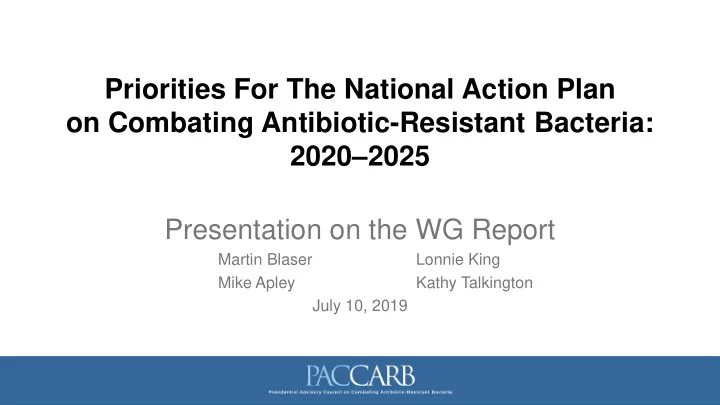

Priorities For The National Action Plan on Combating Antibiotic-Resistant Bacteria: 2020–2025 Presentation on the WG Report Martin Blaser Lonnie King Mike Apley Kathy Talkington July 10, 2019
Working Group Members • Council Members (voting and liaison) • Interagency CARB Task Force Members – HHS: CDC, FDA, AHRQ, CMS, ASPR, ASPE, NIH, OGA – DoD, State, USAID, EPA – USDA: APHIS, ARS, FSIS
MARTY BLASER
Process • Tasked by Secretary in September 2018 to identify 3-5 emerging areas within the five NAP goals • RFI posted for public feedback, January Public meeting held with 31 panelists, then WG met to discuss feedback and distill recommendations to the Secretary – Council members developed the recommendations, the Task Force helped inform the process • Identified 17 distinct recommendations across the five NAP goals
MARTY BLASER RFI open from November 23, 2018 – January 7, 2019 180 responses from 67 respondents
Report Organization • Figure in Executive Summary summarizes five major identified priorities (top) • Three additional priorities to incorporate across all five goals (bottom) • Body of the report includes introduction and background, and then provides explanations for each recommendation with sub-bullets, by Goal.
LONNIE KING
Goal 1 S LOW THE E MERGENCE OF R ESISTANT B ACTERIA AND P REVENT THE S PREAD OF R ESISTANT I NFECTIONS Priority 1: Advance implementation of IP and AS programs through measurable, outcomes-based research. Priority 2: Widely implement IP and AS strategies that have been proven effective throughout healthcare settings and animal agriculture. Priority 3: Promote AS in companion animal health settings. Priority 4: Facilitate and support the adoption of new technologies and management practices that can reduce the need for antibiotic use in animal agriculture. Priority 5: Increase the use and interoperability of data systems to support AS.
MIKE APLEY
Goal 2 S TRENGTHEN N ATIONAL O NE H EALTH S URVEILLANCE E FFORTS TO C OMBAT R ESISTANCE Priority 1: Enhance antibiotic use and resistance reporting systems for human and animal health. Priority 2: Expand AMR reporting through NARMS and fund supporting research. Priority 3: Understand the role of antibiotics and resistance in the environment.
KATHY TALKINGTON
Goal 3 A DVANCE D EVELOPMENT AND U SE OF R APID AND I NNOVATIVE D IAGNOSTIC T ESTS FOR I DENTIFICATION AND C HARACTERIZATION OF R ESISTANT B ACTERIA Priority 1: Support studies that use clinical outcomes to evaluate the use of diagnostics and advance their integration into care. Priority 2: Develop incentives and reimbursement strategies to support uptake of diagnostics. Priority 3: Promote and support the development of new diagnostics and their integration into stewardship and AMR prevention programs in both human and animal health settings.
MIKE APLEY
Goal 4 A CCELERATE B ASIC AND A PPLIED R ESEARCH AND D EVELOPMENT FOR N EW A NTIBIOTICS , O THER T HERAPEUTICS , AND V ACCINES Priority 1: Adopt effective pull incentives for development of new antibiotics, vaccines, and alternatives. Priority 2: Continue to create push incentives for development of new antibiotics, vaccines, and alternatives. Priority 3: Advance research on optimal dose and duration of existing antibiotic therapies. Priority 4: Address shortages of existing antibiotics.
KATHY TALKINGTON
Goal 5 I MPROVE I NTERNATIONAL C OLLABORATION AND C APACITIES FOR A NTIMICROBIAL P REVENTION , S URVEILLANCE , C ONTROL , AND A NTIMICROBIAL R ESEARCH AND D EVELOPMENT Priority 1: Enhance U.S. leadership in the global fight against AMR. Priority 2: Promote and support AMR activities in low- and middle- income countries.
MIKE APLEY
Additional Recommendations: Five Years and Beyond • Integrate antibiotic resistance surveillance systems for One Health surveillance. • Develop an integrated federal One Health research strategy. • Develop a national, interagency effort to address antibiotic resistance issues around the globe.
LONNIE KING
Discussion and Vote
Recommend
More recommend